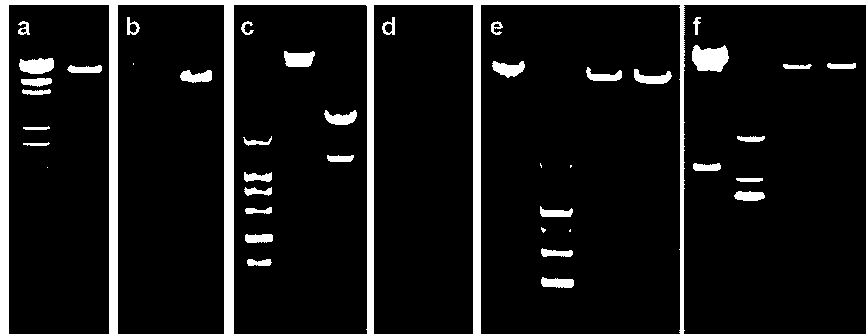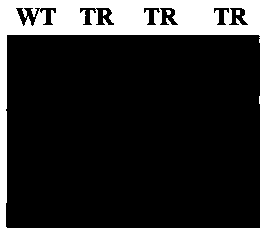Formaldehyde dehydrogenase gene CcFALDH and use thereof
A technology of formaldehyde dehydrogenase and gene, applied in application, genetic engineering, plant genetic improvement, etc., can solve the problem that formaldehyde dehydrogenase gene has not been reported yet
- Summary
- Abstract
- Description
- Claims
- Application Information
AI Technical Summary
Problems solved by technology
Method used
Image
Examples
Embodiment 1
[0029] Embodiment 1, the cloning of Chlorophytum formaldehyde dehydrogenase gene
[0030] From the NCBI database (http: / / www.ncbi.nlm.nih.gov / ), search and save the formaldehyde dehydrogenase sequence of higher plants, using the known Arabidopsis, pea, corn, rice and pothos in the database (NM_123761.3, Y11029, AK099733.1, AB618795) formaldehyde dehydrogenase sequences were compared. Degenerate primers were designed according to the conserved amino acid sequences. In order to facilitate the construction of recombinant plant expression vectors, the 5' ends of the upstream and downstream primers were respectively introduced BamH I and Sac I restriction enzyme sites, primer sequences are as follows:
[0031] FALDH-F: CGGAATTCATGGCKACHSAGGSHCAGG
[0032] FALDH-R: CGAGCTCTYASAYYTGCRTVKCMAG
[0033] RNA extraction: RNAprep pure Plant Kit (TianGen) was used to extract RNA from leaves of Chlorophytum comosum treated with 5mM formaldehyde for 1 hour, and reverse-transcribed into cDNA...
Embodiment 2
[0039] Embodiment 2, the construction of plant expression vector pBI-35S-FALDH
[0040] Restriction sites BamH I and Sac I were respectively introduced into the primers during gene cloning. The cloning vector pMDCcFALDH plasmid containing the CcFALDH gene was double digested with BamH I and Sac I. For the enzyme digestion system, refer to the manual of restriction endonuclease double digestion reaction of Takara Company, and react at 37°C for 12 hours. The target fragment of CcFALDH with cohesive ends was recovered.
[0041] The plasmid DNA of the binary plant expression vector pBI121 was digested with BamH I and Sac I, reacted at 37°C for 12 hours, and the large fragment, namely the pBI121 vector backbone, was recovered.
[0042] Ligate the fragment of interest to the parent vector. The ligation product was transformed into TOP10 competent cells. Single colonies were picked for PCR identification. Plasmids were extracted from colonies positive for PCR, and BamH I and Sac...
Embodiment 3
[0043] Embodiment 3, detection of CcFALDH gene transformed plant and transgenic plant
[0044] The successfully constructed plant expression vector pBI-35S-FALDH was introduced into Agrobacterium EHA105 by electroporation, and colony PCR identification was carried out, and a product of about 1200bp was obtained. Extract the PCR-positive colony plasmid, carry out enzyme digestion, and obtain a fragment of about 1200bp, which proves that the transformation vector has been transferred into Agrobacterium ( figure 2 -f).
[0045] Inoculate single Agrobacterium colonies identified by colony PCR into 5ml YEB liquid medium containing 100 μg / ml KM, culture overnight at 28°C with shaking at 200 rpm, and transfer them into 50ml YEB liquid medium the next day , at 28°C, shake culture at 200 rpm to OD60, when the value is 0.4-0.6, collect the bacteria, suspend with MS liquid medium, and set aside.
[0046] Transfer the recombinant overexpression vector pBI-35S-FALDH obtained above into ...
PUM
| Property | Measurement | Unit |
|---|---|---|
| Molecular weight | aaaaa | aaaaa |
Abstract
Description
Claims
Application Information
 Login to View More
Login to View More - R&D
- Intellectual Property
- Life Sciences
- Materials
- Tech Scout
- Unparalleled Data Quality
- Higher Quality Content
- 60% Fewer Hallucinations
Browse by: Latest US Patents, China's latest patents, Technical Efficacy Thesaurus, Application Domain, Technology Topic, Popular Technical Reports.
© 2025 PatSnap. All rights reserved.Legal|Privacy policy|Modern Slavery Act Transparency Statement|Sitemap|About US| Contact US: help@patsnap.com



